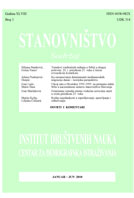Grupisanje zemalja prema vodećim uzrocima smrti u svetu početkom 21. veka
Classifying Countries According to Leading Causes of Death in the World at the Beginning of the 21st Century
Author(s): Ivan Ž. MarinkovićSubject(s): Evaluation research, Health and medicine and law, Demography and human biology, Globalization
Published by: Институт друштвених наука
Keywords: mortality; causes of death; cluster analysis; world in 2002; regionalization;
Summary/Abstract: Cause mortality of a population is an important segment in the analysis of mortality, because it sums up all factors which influence death indicators on a certain territory in a direct way. At the beginning of the 21st century, the situation is not the same everywhere in the world and countries do not share a unique pattern of the causes of deaths. Infectious and parasitic diseases are still dominant in underdeveloped countries, while the leading causes of deaths in developed countries are circulatory disorders and neoplasm. Cardiovascular diseases are the cause of 29% of total mortality in the world, infectious cause 19%, tumors 13% and violent deaths about 9% (based on data from 2002). This paper gives an analysis of the spatial distribution of the leading causes of deaths using the geographic information system (Arc-View GIS), based on the ratio of total mortality and death rates of the population from a certain group of diseases. Based on data analysis, a hypothesis has been set on the significance of the regional factor in forming a picture of population mortality according to causes of death. A regional factor implies a set of physicalgeographical as well as general social specificities of a certain region which form a pattern of population behavior. Based on death rates, cardiovascular diseases are represented the most in the mortality rates of countries in Eastern and Southeastern Europe. Infectious diseases imperil the population in the Sub-Saharan region of Africa; tumors are most common in Europe, North America and Japan. The highest rates of violent deaths are in countries of the former Soviet Union and the Sub-Saharan zone. Classifying death rates according to leading causes of death represents a prerequisite for forming a final picture of mortality according to causes of death in the world at the beginning of the "new century". The method of gathering together the causes of death is possible by applying a statistical model of classifying data (cluster analysis). The countries of the world have been classified into eight clusters according to the leading causes of death for the year 2002. Developed countries have been classified into three clusters based on this analysis. The Arab world has been singled out in a separate cluster, and the specific traits of Middle Asian countries also deserved separate classification. Countries of the Indian subcontinent and South East Asia, as well as Sub-Saharan Africa and South America formed regions on the basis of a combination of the leading causes of death. As opposed to epidemic transition, which tried to determine a uniform trend of the causes of death for all countries of the world, the cluster data analysis shows the significance of the regional factor when forming the depiction on the leading causes of death. Modeling population mortality based on data on causes of deaths structure bears much information, primarily in which direction should the health policies of a country flow and what are the priorities for decreasing mortality and increasing life expectancy.
Journal: Stanovništvo
- Issue Year: 48/2010
- Issue No: 1
- Page Range: 75-101
- Page Count: 27
- Language: Serbian

